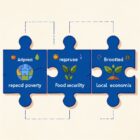9 Best Ways SNAP Benefits Bolster Economic Stability

Imagine a powerful force sweeping through the economy, strengthening businesses, creating jobs, and reducing poverty. SNAP benefits, or the Supplemental Nutrition Assistance Program, do just that.
In this article, we will explore the nine best ways that SNAP benefits bolster economic stability.
With increased spending power, support for local businesses, and improved health and productivity, SNAP benefits play a crucial role in shaping a more prosperous future for all.
Discover the data-driven evidence and objective analysis behind this transformative program.
Key Takeaways
- SNAP benefits contribute to overall economic stability by alleviating financial stress.
- Increased demand for groceries and essential items directly benefits local businesses, especially in the food industry.
- Job creation occurs as local businesses hire additional staff to meet customers’ needs.
- Every $1 increase in SNAP benefits leads to a $1.54 increase in GDP.
Increased Spending Power
When you receive SNAP benefits, your increased spending power can have a positive impact on your economic stability. The Supplemental Nutrition Assistance Program (SNAP) is designed to provide low-income individuals and families with funds to purchase nutritious food. By increasing your purchasing power, SNAP benefits help alleviate financial stress and contribute to overall economic stability.
According to data from the U.S. Department of Agriculture (USDA), SNAP benefits have a significant effect on household spending. On average, SNAP recipients spend almost 90% of their benefits within one month of receiving them. This increased spending stimulates economic activity, benefiting not only the recipients but also local businesses and the broader economy.
Moreover, a study published in the American Journal of Agricultural Economics found that for every dollar of SNAP benefits spent, there’s an estimated $1.79 increase in total economic activity. This multiplier effect is due to the fact that increased spending by SNAP recipients generates income for businesses and their employees, who in turn spend that income on goods and services, creating a ripple effect throughout the economy.
Stimulating Local Businesses
By increasing your purchasing power, SNAP benefits contribute to economic stability by stimulating local businesses. Here’s how:
1) Increased demand: With SNAP benefits, you have more money to spend on groceries and other essential items. This increased demand for goods and services directly benefits local businesses, especially those in the food industry. As you purchase groceries from local stores, farmers markets, and food cooperatives, you support local farmers, suppliers, and retailers, creating a ripple effect of economic activity within your community.
2) Job creation: As local businesses experience higher demand, they may need to hire additional staff to meet customers’ needs. This leads to job creation within your community, providing employment opportunities for residents. By stimulating local businesses through your SNAP benefits, you contribute to reducing unemployment rates and improving the overall economic well-being of your community.
3) Small business support: Local businesses, particularly small businesses, play a crucial role in the local economy. SNAP benefits help support these small businesses by providing them with a steady customer base. By choosing to spend your SNAP benefits at local establishments, you help sustain these businesses, enabling them to thrive and continue contributing to the local economy.
By stimulating local businesses, SNAP benefits not only provide economic stability but also pave the way for job creation and employment support within your community.
In the next section, we’ll explore how SNAP benefits further contribute to economic stability through job creation and employment support.
Job Creation and Employment Support
Boost your community’s economy and employment opportunities with SNAP benefits. By providing low-income individuals and families with access to nutritious food, SNAP not only improves their well-being but also has a positive impact on the economy as a whole.
According to a study conducted by the U.S. Department of Agriculture, every $1 increase in SNAP benefits leads to a $1.54 increase in GDP. This boost in economic activity translates into job creation and employment support.
SNAP benefits stimulate demand for food and other goods, which in turn creates a demand for labor. Local businesses, such as grocery stores and farmers markets, benefit from increased sales and can hire additional employees to meet the growing demand. Moreover, the increased purchasing power of SNAP recipients allows them to spend more on other goods and services, supporting a wide range of industries and creating job opportunities in various sectors of the economy.
By generating employment opportunities, SNAP benefits contribute to reducing unemployment rates and fostering economic stability in communities. This not only benefits those directly receiving SNAP benefits but also has a ripple effect, improving the overall economic health of the community.
Transitioning into the subsequent section about ‘improved health and productivity’, it’s essential to recognize the correlation between access to nutritious food through SNAP benefits and its impact on individual well-being.
Improved Health and Productivity
To enhance your overall well-being and productivity, access to nutritious food through SNAP benefits plays a crucial role. Here are three ways in which SNAP benefits contribute to improved health and productivity:
- Reduced healthcare costs: By providing access to nutritious food, SNAP benefits help prevent chronic diseases such as obesity, diabetes, and heart disease. According to a study published in the American Journal of Public Health, every dollar spent on SNAP benefits results in a decrease of healthcare costs by $1.79. This reduction in healthcare expenses not only improves your health but also frees up resources for other necessities, boosting your productivity.
- Improved cognitive function: Proper nutrition is essential for optimal brain function. SNAP benefits ensure that individuals have access to a variety of nutrient-rich foods, including fruits, vegetables, whole grains, and lean proteins. Research conducted by the Food Research and Action Center shows that children who receive SNAP benefits have better cognitive development and perform better academically. This improved cognitive function translates into increased productivity in school and future employment.
- Enhanced workforce productivity: When individuals have access to nutritious food, they’re more likely to have better physical and mental health. This, in turn, leads to increased workplace productivity. A study by the Center for Economic and Policy Research found that SNAP benefits have a positive impact on employment rates and earnings. By reducing food insecurity and promoting better health, SNAP benefits contribute to a more productive workforce.
Reduced Poverty and Income Inequality
Access to SNAP benefits not only improves health and productivity but also contributes to reduced poverty and income inequality.
The Supplemental Nutrition Assistance Program (SNAP) plays a crucial role in alleviating poverty and reducing income inequality in the United States. According to data from the U.S. Census Bureau, SNAP lifted approximately 3.6 million people out of poverty in 2019. This represents a 10.3% reduction in the official poverty rate. Additionally, SNAP benefits have been found to have a particularly positive impact on child poverty rates. Research shows that SNAP reduced child poverty by 5.2% in 2019.
Furthermore, SNAP helps reduce income inequality by providing a safety net for low-income individuals and families. It helps to ensure that those who are struggling to make ends meet have access to nutritious food, freeing up their limited financial resources for other essential needs. This targeted assistance helps to level the playing field and reduce the income gap between the rich and the poor.
Boosting Agricultural and Food Industries
With SNAP benefits, farmers and food industry workers experience an increase in demand for their products, leading to economic growth and stability for the agricultural and food industries. This boost is significant and has several key effects:
- Increased sales: SNAP benefits enable low-income individuals and families to afford nutritious food, which in turn leads to higher demand for agricultural products. This increased demand stimulates sales for farmers and food industry workers, providing them with a more stable income stream.
- Job creation: The rise in demand for agricultural products leads to the need for more workers in the industry. Farmers may need to hire additional labor to meet the increased demand, while food processing and distribution companies may expand their workforce to keep up with the higher production levels. This job creation not only benefits individuals by providing employment opportunities but also contributes to overall economic growth.
- Market stability: SNAP benefits act as a stabilizing force in the agricultural and food industries. By providing a consistent source of income for low-income individuals, SNAP helps maintain a steady demand for food products even during economic downturns. This stability allows farmers and food industry workers to plan and invest in their businesses more confidently, contributing to the long-term sustainability of the industry.
As the agricultural and food industries thrive with the support of SNAP benefits, it becomes crucial to focus on strengthening food security.
Strengthening Food Security
To strengthen food security, SNAP benefits play a crucial role in reducing food insecurity and promoting economic resilience. By providing eligible individuals and families with access to nutritious food, SNAP helps alleviate hunger and ensures that basic nutritional needs are met.
Additionally, by boosting the purchasing power of low-income households, SNAP dollars have a multiplier effect on local economies, generating economic activity and fostering stability.
Reducing Food Insecurity
By ensuring a steady supply of nutritious food for individuals and families, SNAP benefits contribute to reducing food insecurity. Here are three ways in which SNAP benefits help strengthen food security:
- Increased access to healthy food: SNAP benefits allow low-income individuals and families to purchase a variety of nutritious foods. By providing financial assistance, SNAP helps to ensure that individuals have access to a balanced diet, reducing the risk of malnutrition and promoting overall health.
- Alleviating hunger: SNAP benefits play a crucial role in alleviating hunger among vulnerable populations. By providing families with the means to purchase food, SNAP helps to ensure that no one goes hungry, especially during times of economic hardship or crisis.
- Supporting local economies: SNAP benefits not only benefit recipients but also support local economies. When individuals use their benefits to purchase food, it stimulates economic activity and helps to sustain local businesses, including grocery stores and farmers’ markets.
Promoting Economic Resilience
You can further strengthen food security and promote economic resilience by maximizing the impact of SNAP benefits. SNAP benefits play a crucial role in reducing food insecurity and poverty rates, but there are additional steps that can be taken to enhance their effectiveness.
Implementing strategies such as expanding access to healthy foods, increasing nutrition education, and supporting local food systems can help individuals and families not only obtain enough food but also improve their overall economic stability.
Expanding access to healthy foods through initiatives like farmers markets and community gardens can provide SNAP recipients with fresh and nutritious options. This not only improves their health outcomes but also supports local farmers and stimulates the local economy.
Additionally, nutrition education programs can equip individuals with the knowledge and skills needed to make healthier food choices on a limited budget. By teaching them how to shop for nutritious foods and prepare meals at home, SNAP recipients can stretch their benefits and improve their long-term food security.
Supporting local food systems is another effective way to promote economic resilience. By investing in local agriculture and food production, SNAP benefits can be used to support small businesses and create jobs in the community. This not only strengthens the local economy but also reduces reliance on external food sources, making the community more resilient to disruptions in the food supply chain.
Supporting Small Farmers and Producers
Supporting small farmers and producers through SNAP benefits is essential for boosting the local food economy and encouraging sustainable farming practices.
By providing low-income individuals and families with access to fresh, locally grown produce, SNAP not only supports the livelihoods of small-scale farmers but also promotes healthier food choices.
Additionally, SNAP benefits can help reduce food waste by connecting small farmers with a reliable market, ensuring that their hard work and investment in sustainable agriculture doesn’t go to waste.
Boosting Local Food Economy
When utilizing SNAP benefits, one effective way to bolster economic stability is by actively contributing to the growth of the local food economy, which supports small farmers and producers. By choosing to purchase your groceries from local farmers and producers, you aren’t only accessing fresh and nutritious food, but you’re also supporting the local economy.
Here are three reasons why boosting the local food economy is beneficial:
- Economic impact: Supporting local farmers and producers helps to keep money within the community. According to a study by the USDA, for every dollar spent on locally produced food, an additional $1.80 is generated in the local economy.
- Job creation: Small farmers and producers play a crucial role in creating employment opportunities. By supporting them, you’re contributing to the growth of the local workforce and helping to strengthen the local job market.
- Environmental sustainability: Local food systems often prioritize sustainable farming practices, such as organic farming and reduced transportation distance. By choosing to buy locally, you’re reducing the carbon footprint associated with long-distance transportation and supporting environmentally friendly practices.
Encouraging Sustainable Farming
By actively contributing to the growth of the local food economy, SNAP beneficiaries can encourage sustainable farming practices and support small farmers and producers.
Sustainable farming is essential for environmental preservation and long-term economic stability. Supporting small farmers and producers helps in diversifying the local food system, reducing dependence on large-scale, industrial agriculture. According to a study conducted by the Union of Concerned Scientists, sustainable farming practices can increase soil fertility, decrease water pollution, and reduce greenhouse gas emissions. Additionally, sustainable farming methods prioritize the use of organic fertilizers and pesticides, which minimize the exposure to harmful chemicals for both farmers and consumers.
Long-term Economic Benefits
To maximize your long-term economic benefits, it’s important to prioritize the effective utilization of your SNAP benefits. By making strategic choices and investing wisely, you can create a foundation for future financial stability.
Here are three key ways that SNAP benefits can help you achieve long-term economic success:
- Education and Training: Use a portion of your SNAP benefits to invest in your education and skills development. This could include enrolling in vocational training programs, community college courses, or online certifications. By acquiring new skills, you increase your employability and open up opportunities for higher-paying jobs.
- Healthy Food Choices: Allocating your SNAP benefits towards nutritious foods can have a significant impact on your long-term health and financial well-being. By purchasing fresh fruits, vegetables, whole grains, and lean proteins, you can reduce the risk of chronic diseases and lower healthcare costs in the future.
- Savings and Investments: Establishing a savings plan and setting aside a portion of your SNAP benefits can help you build an emergency fund and create a safety net for unexpected expenses. Furthermore, consider exploring investment options to grow your wealth over time, such as low-risk mutual funds or retirement accounts.
Frequently Asked Questions
How Does the SNAP Program Specifically Target Low-Income Individuals and Families?
SNAP specifically targets low-income individuals and families by providing them with financial assistance for purchasing nutritious food. This program helps alleviate food insecurity and promotes economic stability by ensuring basic needs are met.
What Are Some Examples of Local Businesses That Have Benefited From Increased Spending Power Through SNAP Benefits?
Local businesses such as grocery stores, farmers markets, and restaurants have experienced increased sales and revenue due to the spending power provided by SNAP benefits. This has helped boost economic stability in their communities.
Can SNAP Benefits Be Used to Support Job Training or Education Programs?
Yes, SNAP benefits can be used to support job training or education programs. They provide financial assistance that can help individuals gain skills and qualifications, leading to better employment opportunities and increased economic stability.
How Does Access to Nutritious Food Through SNAP Benefits Contribute to Improved Health Outcomes?
Access to nutritious food through SNAP benefits contributes to improved health outcomes by providing individuals with the means to purchase healthy food options. This leads to better nutrition, decreased risk of chronic diseases, and overall improved well-being.
What Measures Are in Place to Ensure That SNAP Benefits Are Being Used for Their Intended Purpose and Not Being Abused or Misused?
Measures are in place to ensure SNAP benefits are used properly. Fraud prevention programs, such as income verification and transaction monitoring, help prevent abuse and misuse. These measures protect the program’s integrity and ensure assistance reaches those who need it most.



